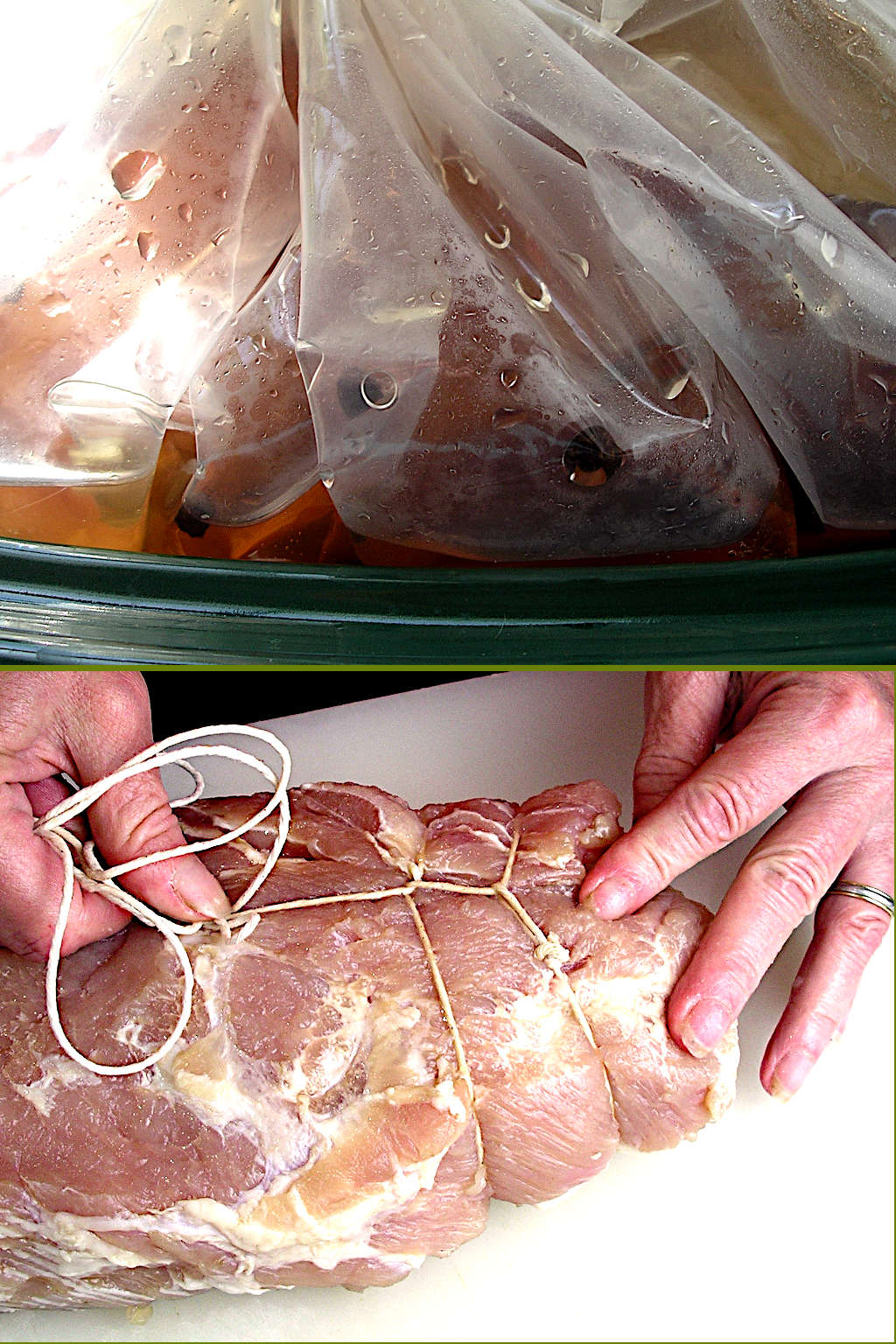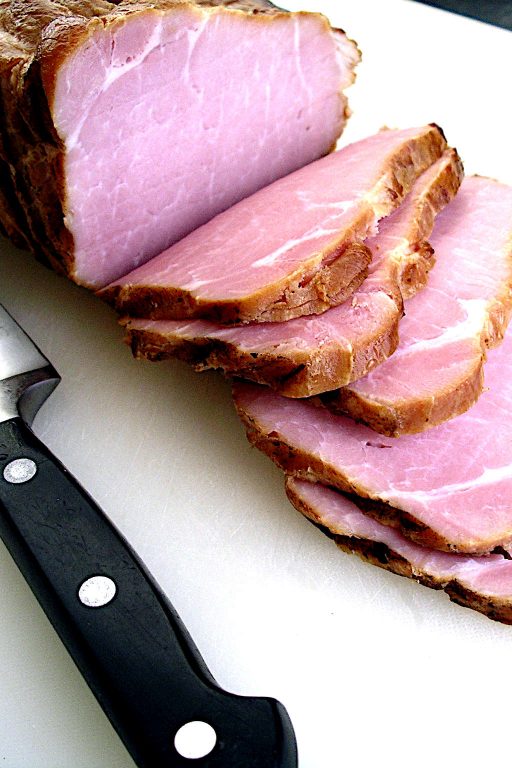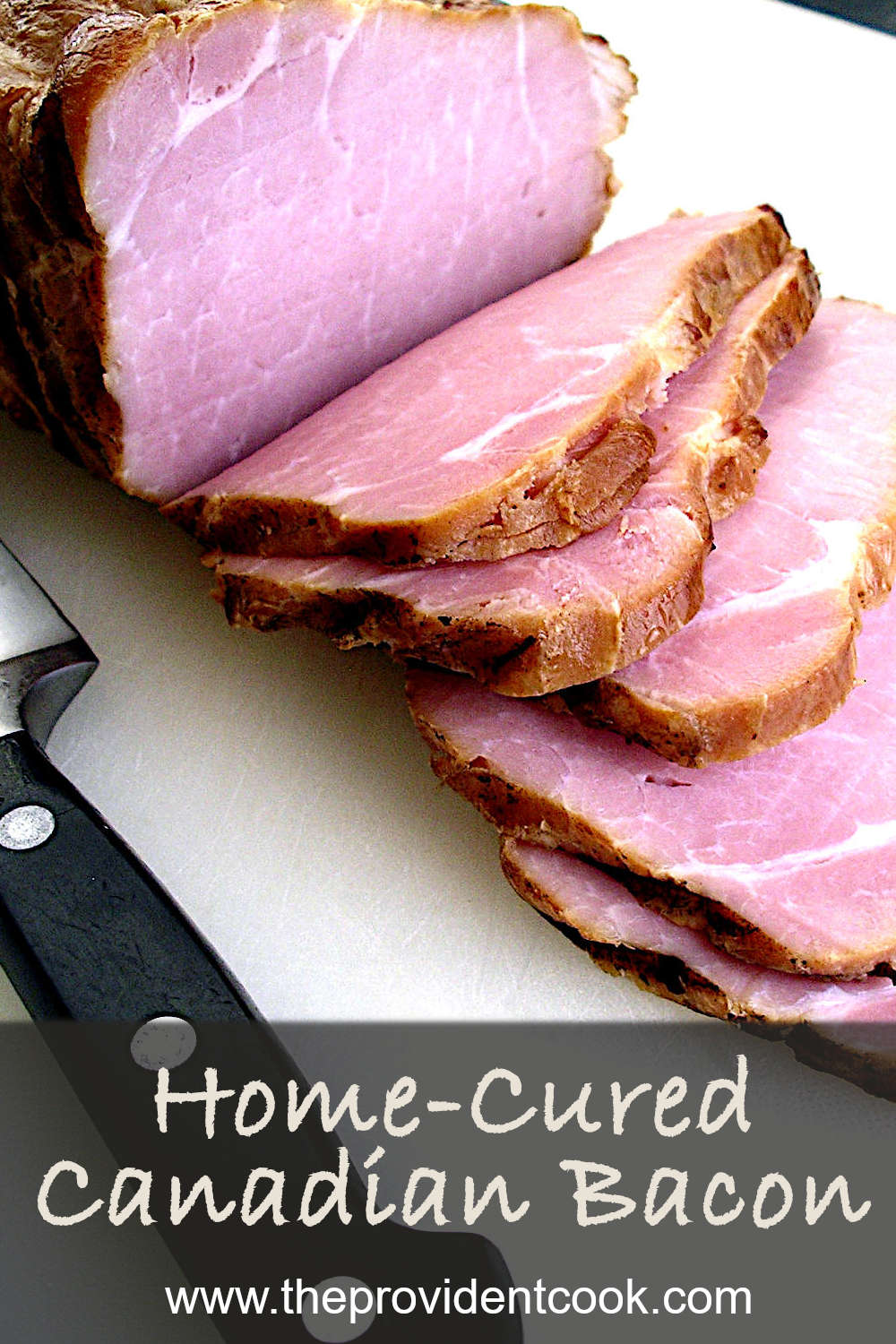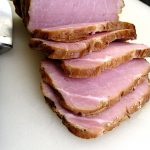Home-cured Canadian bacon is amazingly easy to make and takes only a couple of specialized things — plus a bit of time. And it’s far less expensive than the little packets at your grocery store!
I love Canadian bacon for Eggs Benedict, Hawaiian-style pizza (though I know that’s a controversial thing) and so much more. But the little five- to six-ounce vacuum-sealed packs I bought for years at my local grocery store were fairly expensive. I ran the numbers recently, and even on sale, those packets work out to $7.50 to $9.50 a pound! That’s the max price I look for in STEAK! Which meant Canadian bacon was a rare treat at our house.
Hmmmm. There had to be a better way.
A New Adventure
Curing meats is something humankind has been doing for centuries, long before the large commercial processors, as a way of preserving. I knew I could get half pork loins on sale at around $1.89 a pound, and even at full price, they’re around $4/pound. Pork loin (as opposed to pork tenderloin, a different cut entirely) is precisely what Canadian bacon is made from. And thus began what I call The Great Home-Curing Adventure.
I found Morton Tender Quick, which contains both sodium nitrate and nitrite, in the spice aisle at my favorite grocery store. My first attempt was a “dry” cure following a recipe on the Morton Salt site. In a “dry” cure, you simply rub the dry curing ingredients onto the surface of the meat, wrap it tightly in plastic wrap, and refrigerate for several days.
For me, anyway, the dry cure resulted in an incredibly salty, almost inedible product. Sigh. A “wet” cure, where the salts, spices, etc. are dissolved in water before curing, seemed like the answer, and I found several examples from various sources. On my first attempt at this method, I had a winner – and I’ve never looked back.
Making Home-Cured Canadian Bacon
As mentioned, making your own home-cured Canadian bacon takes just a few specialized things, some of which are optional but ‘nice-to-haves.’
- A curing agent. Morton Tender Quick is readily available here in the Midwest but may be harder to find on the coasts. Another option is InstaCure #1 or #2, sometimes called Prague powder #1 or #2, or “pink salt.” All contain nitrites, which inhibit bacterial growth and give cured meats that characteristic “pink” color. Some contain nitrates as well, and all contain plain old salt. Tender Quick contains some sugar, while the others do not; the amount used here shouldn’t make much difference. Don’t confuse “pink salt” with Himalayan pink salt, though. It doesn’t contain nitrites or nitrates.
- A large pot or Dutch oven in which to dissolve the curing ingredients by boiling.
- A very large vessel in which to submerge the pork loin in the curing solution during the curing process. I use the insert for my 6-quart slow cooker. You can use a small saucer or salad plate to keep the loin submerged. I’ve found that with this method, even if I turn the loin over at least once a day, the curing solution still doesn’t penetrate evenly. So I use a large zip-top curing bag as you see in the top image below (a 2-gallon or larger bag should work fine).
- Seasonings, in this case, light brown sugar, bay leaves, garlic cloves, and black peppercorns. You can also add sprigs of thyme and rosemary and other seasonings to your taste.
- A smoker or barbecue that can hold a temperature of 225° to 250°. There are a number of sites that can guide you on how to smoke foods on a charcoal or gas barbecue, the Weber site is one. We like to use fruitwood for the smoking, like apple, etc.

The Process
The process is really quite simple, and a lot of it is hands-off. First you combine the cure ingredients with water, bring it to a boil and make sure the sugar and salts are fully dissolved. Remove from heat, cool to room temperature, then add the cooled cure and additional water to your curing vessel or bag. Chill it thoroughly in the refrigerator.
Pork loin sometimes has a layer of fat on it, which I remove. Also check the pork loin for silverskin, a thin layer of connective tissue that is tough and inedible. Run a thin knife underneath it, holding the blade at an upward angle, to remove it. Once the curing solution has cooled, add the prepared pork loin to it and make sure it’s fully submerged. Refrigerate for 5 to 7 days (I usually go the full 7 days just to be sure the cure has penetrated all the way to the center of the loin).
On smoking day, remove the meat from the cure and place it back in the large vessel; cover it with water and let it sit for at least 30 minutes while you light your smoker or grill and bring it to 225° to 250°. I like to tie the pork loin to help form it into more of a rounded shape. I tie it as shown in the photo above with one long string, but individual pieces of string tied around the loin will work fine too.
Smoke the Canadian bacon for about 2 to 3 hours, or until the center reaches 140°. Remove from heat, cool and slice as desired. It freezes well; I freeze it in four-slice packets.
PrintHome-Cured Canadian Bacon
Home-cured Canadian bacon is amazingly easy to make and takes only a couple of specialized things — plus a bit of time. And it’s far less expensive than the little packets at your grocery store!
- Prep Time: 30
- Cook Time: 180
- Total Time: 3 hours 30 minutes + 7 days
- Yield: 20 servings 1x
- Category: breakfast
- Method: smoking
- Cuisine: American
Ingredients
3 quarts (12 cups) water, divided use
3/4 cup kosher salt
3/4 cup light brown sugar
1 1/2 teaspoons curing salt (Tender Quick, InstaCure, Prague Powder, “pink salt”, see note)
3 large bay leaves
2 medium garlic cloves, peeled and smashed with the side of a knife
2 teaspoons whole black peppercorns
3 sprigs fresh thyme, or 1/2 teaspoon dried thyme, optional
2 sprigs fresh rosemary, or 1 teaspoon dried rosemary, optional
1 boneless pork half loin, about 3 pounds
Instructions
Make the curing solution: Combine 6 cups (1 1/2 quarts) water and the rest of the ingredients except the pork loin. Bring to a boil over high heat, stirring to dissolve the salts and sugar. Boil for 1 minute, then remove from heat and cool to lukewarm.
Transfer the curing solution to a large container or brining bag and add the remaining 1 1/2 quarts (6 cups) water. Chill thoroughly in the refrigerator. Trim the loin of any excess fat and silverskin. Fully submerge the pork loin in the curing solution and refrigerate for 5 to 7 days.
Remove the pork loin from the curing solution and place it in a large container. Add enough fresh water to fully submerge it and let it sit for 30 min. Remove from the water and pat it dry with paper towels.
Heat smoker or grill to 225 to 250 degrees and add smoking wood chunks once it has reached temperature. While the smoker or grill is heating, if desired, use kitchen twine to tie the pork loin into a rounded shape. When the smoker or grill is smoking well, put the pork in the smoker and cook until an instant-read thermometer reaches 140 degrees when inserted in the thickest part of the loin, 2 to 3 hours. Let the pork loin cool for 30 minutes. Slice immediately and pan-fry, or cool it completely, slice as desired and freeze in serving-size packages.
Notes
“Pink salt” should not be confused with Himalayan pink salt, which contains no nitrites or nitrates. Adapted from meatwave.com and other sources.
Keywords: canadian bacon



